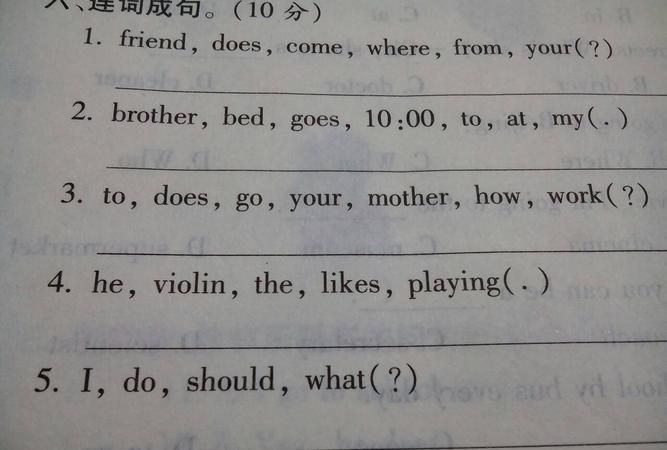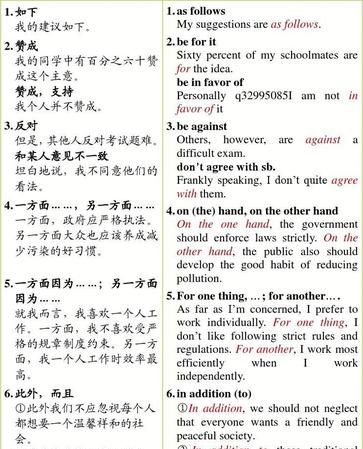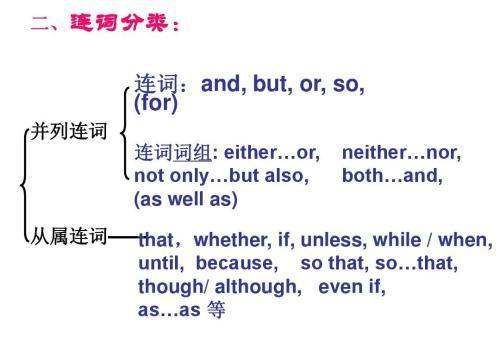本文目录
英语作文连接词和过渡词带翻译
英语作文连接词和过渡词:为了突出文章的层次感和逻辑性,文章应尽量使用过渡词和连接词,即表示起承转合的词汇。过渡词有利于考生表达自己的思想,更有利于使阅卷老师顺畅地阅读考生的作文,制造清晰的得分机会。考生绝不可轻视过渡词或连接词的作用。
连接词:
1、英语作文常用连接词一,表逻辑上的先后顺序。
(1) 首先first,firstly,in the first place,in the first instance,to begin with
(2) 其次secondly,in the second place
(3) 最后,最重要的是at last,finally,last,lastly,most importantly
(4) 最后但并非最不重要的(一点)是,最后要说的是last but not least
2、英语作文常用连接词二、表递进关系。
(1) (副词)也;而且,还also,too,besides
(2) (并列连接词)而且and
(3) 此外in addition to,apart from
(4) 此外furthermore,what’s more
3、英语作文常用连接词三、表转折或比较关系。
(1) (并列连接词)但是but
(2) (副词)然而(and)yet,while,whereas
(3) (副词)然而nevertheless,however
(4) (从属连接词)尽管,虽然though,although
(5) 相反,正相反,恰恰相反to the contrary,on the contrary,quite the contrary
4、英语作文常用连接词四、表例证关系。
(1) 也就是说namely,that is,that is to say
(2) 例如for example,for instance
(3) 举例来说to illustrate
(4) 例如such as
5、英语作文常用连接词五、表因果关系。
(1) (后接表原因的从句)因为because
(2) (后接表原因的并列分句)因为for
(3) 因为……because of…,,owing to…,on account of…
(4) 因为这个那个,这些那些原因for this(that,these,those)reason(s)
(5) (从句1)为了……in order that
(6) (副词)因此,所以thus,hence,therefore
(7) 那么then
(8) 结果(是)as a result;so that(后接表结果的从句)
6、英语作文常用连接词六、表观点。
(1) 在我看来in my opinion,in my view
(2) 我本人认为,我个人的看法是personally,as far as Im concerned
(3) 我认为I think(that从句),as a rule
(4) 一般来说generally(speaking),in general
(5) 坦率地说frankly speaking,to be frank
过渡词:
A. 文章及段落起始过渡词语
1、 To begin with
2、Generally speaking
3、First of all
4、In the first place
B. 文章及结尾常用的过渡词语
1、Therefore
2、 Thus
3、 This way
4、In conclusion
5、 To sum up
6、In a word
7、As a matter of fact

C. 常见的表示先后顺序的过渡词语
1、 First,… Second, … Next, … Finally, …
2、 Afterwards, …
3、 Meanwhile, …
4、 Then, …
D. 常见的对称关系的过渡词语
1、 For one thing, … for another thing, …
2、On one hand, … on the other hand, …
E. 常见的表示因果关系的过渡词语
1、For this reason
2、 As a result
3、 because of
英语作文常用连接词顺序连接词
1.表示并列、平行关系:
and 和 both…and 两个都 as well as 也,又 as well=also =too也
not…but…不是……而是 neither…nor即不…….也不
that…but that…不是因为……而是因为 not only…but also不仅….而且
The drops of rain make a hole in the stone, not by violence, but by falling.
滴水穿石,不是靠努力,而是靠持之以恒.
2. 表示转折关系:
but 但是 however然而 yet然而 else=otherwise=or否则
Love is all well in its way, but friendship is much higher. 爱情诚可贵,友情价更高.
3. 表示选择关系:
or或者 either…or…要么…要么 whether…or not…是…不是…
With the help of the science and technology, glass can be made as hard as steel, or as soft as silk, or as light as paper, or as heavy as iron.
借助于科学技术,玻璃可以被制作的像钢一样硬,像丝一样柔,像纸一样轻,像铁一样重.
4. 表示对比关系:
on one hand一方面 on the other hand另一方面
while而 similarly 同样地, 类似地 instead (of)相反
rather than而不是 on the cOntrary=conversely相反地
The past belongs to wisdom, the present to action, while to joy the future.
智慧属于过去,行动所以现在,而欢乐属于未来.
5. 表示递进、补充、强调:
besides=in addition=additionally另外、此外 above all最为重要的是
moreover=furthermore而且、此外 what’s more为重要的是
in the meantime =meanwhile同时 especially尤其是
particularly=in particular特别 still仍然、还要
what’s worse =still worse更为严重地 including 包括
Your courage especially your determination can lead to your success in time.
你的勇气,尤其是你的毅力会使你最终走向成功.
6. 表示因果关系:
so(therefore)所以因此 because(as, for)因为 for the reason that由于
as a result(of)结果 for fear that(担心) thus因而、这样、如此
now that(since)既然、由于 thanks\due\owing to=because of 因为
Don’t regret. Don’t complain. Even the sun has black sports. Therefore, it is impossible that there is no dissatisfaction on the world.
莫叹息!莫埋怨!既然太阳也有黑点,人世间的事情就更不可能没有缺陷.
7. 表示让步关系:
although=though=while as=much=that虽然;尽管
even though\if 即使;虽然 after all毕竟
of course\certainly当然 in spite of不顾、不管
If you want to have more roses, you must plant trees. After all, it will never rain roses.
天上没有掉下来的馅饼,不劳而获是不可能的.
8. 表示举例、解释、说明:
in other words换句话说 that is to say也就是说
that is (namely)即、也就是 or rather 更准确地说
such as=like例如、诸如 for example=for instance例如
To think we are able is about to be so, in other words, to determine upon success is frequently success itself. 自信有能力几乎等于有能力,也就是说,决心成功往往就等于成功.
9. 表示目的、结果关系:
so that 以便、为了、结果是 in order that 以便、为了
in order (not) to 为了(不)… so as (not) to 结果是…、为了(不)
We eat in order to live and we live in order not to eat.
我们吃饭是为了活着,但我们活着不是为了吃饭.
10. 表示总结、评述:
in short=in brief总之;简言之 in a word=altogether总而言之
as above-mentioned… 如上所述 That’s no wonder…难怪…
That’s why…那就是…原因 There’s no doubt that…毫无疑问
on the whole 总的来说 personally就我个人而言
in general=generally (speaking) strictly speaking 从严格意义上讲
in the long run 从长远来看 in a sense 从某种意义上
it is obvious that=It’s clear that… as \so far ad I know 就我所知
Clearly=Obviously显而易见 As (it) is known …众所周知…
It is said that…据说… It is reported that…据报道…
It’s suggested that…有人建议… It is hoped that….有人希望…
It is thought that…有人认为… it is proved that…已经证明…
Actually=in fact=as a matter of fact 事实上
to tell the truth=to be hOnest=honestly speaking老实说
11. 表示条件:
unless如果不;除非 in case假使;以防万一 if only要是…就好了
given that考虑到 in that case如果是那样的话 once一旦
provided (that)=providing (that)=on condition that=if如果;条件是
12.表示时间顺序:
at one time=once曾经 once upon a time从前 in (the) future在将来
first=first of all首先 second其次 then然后
after that那以后 next接下来 finally最后
for one thing首先 for another thing其次 before在…之前
after在…之后 at last=in the end最后 in the past在过去
in time=sooner or later终有一天 at present=now=nowadays现在
hardly...when…=no sooner…than….一…就 just then=just at that time正在那时
the moment=the minute=immediately=as soon as 一…就…
也要注意过渡词的用法
1、表示时间的
af first 起初
next 接下来
then 然后
after that 那以后
later 后来
soon 不久
soon/shortly after ……之后不久
finally 最后
in the end 最后
eventually 最终
at last 终于
lately 近来
recently 最近
since then 自从那时起
after that 那以后
in no time 不一会儿
after a while 一会儿
afterward 后来
to begin/start with=in the first place 首先、第一点
immediately 立即、马上
meanwhile=in the meantime=at the same time 在此期间、同时
earlier, until now 直到现在
suddenly=all of a sudden 突然
as a young man 当…… 是个年轻人的时候
at the age of… 在……岁的时候
as early as 早……的时候
as soon as 一……就……
before, the other day 几天前
early in the morning 大清早
after/before dark 天黑后/前
one day 有一天
one afternoon 一天下午
one morning 一天早晨
2、表示空间的
to the right/left 朝右/左
on the rinht/left 在右/左边
in the middle of 在中间
in front of 在前面
in the front of 在前面
at the back of 在后面
at the bottom of 在底部
on the edge of 在……的边上
on top of 在……的顶部
opposite to 与……相对
close to 靠近
near to 在……附近
next to 与……相邻
under 垂直在下
over 垂直在上
below 在下方
above 在上方
across 在……的另一边
around 在周围
behind 在后
before 在前
against 靠着、抵着
further on 再往前
3、表示列举和时序
first, second, third…finally
firstly, secondly, thirdly…finally
first of all, next then, lastly
for one thing…for another…
at the same time
at first
at last
4、表示列举
for example 例如:……
namely 即……
for instance 例如:……
that is (to say) 也就是说
such as 如……
take…for example 拿……来说
like 像……
5、表示比较或对比
like 像
unlike 不像
similarly 同样地
in the same way 以相同的方式
compared to 与……相比
while 而
still=nevertheless 然而
on the contrary 正相反
different from 与……不同
on (the) one hand…on the other hand 一方面……另一方面
in contrast with 与……成对比
6、表示增补
and 而且
both…and 不但……而且
not only…but also 不但……而且
as well as 不但……而且
also=besides=furthermore=more over 此外、而且
in addition 并且
apart from 除了……之外
what's more 而且、更重要的
for another 另一方面
worse still=what's worse=to make matter worse 更糟糕的是
including 包括
7、表示因果
because 因为
since 既然
as 由于
now that 既然
therefore 因此
thus 这样
so 所以
as a result (of) 结果
because of=on account of 因为
thanks to 多亏、由于
for this reason 由于这个原因
if so 如果这样
if not 如果不是这样
8、表示目的
for this purpose
in order to do
so as to do
so that…
in order that…
9、表示让步
though/although
no matter+疑问句
in spite of
whatever/however/whoever
even if/ even though
10、表示递进或强调
besides 况且
what's more 更重要地是
thus 这样
above all 首先
indeed 的确
in fact/ as a matter of fact 事实上
in other words 换句话说
in that case 那样的话
or rather 更确切地说
particularly 特别地
11、表示转折
but 但是
still 然而
however 然而
while 而
12、表示总结
in a/one word 简言之、一句话、总之
generally speaking 一般说来
in short=in a few words 简言之
in cOnclusion=lastly 最后地
on the whole=taking everything into consideration 从总体来看、大体上
so 所以
therefore 因此
thus 这样
as has been mentioned 正如所提到的
it is quite clear that 很显然
there is no doubt that 毫无疑问
it is well-known that 大家都知道
as we all know=as is known
to us all 大家都知道
as/so far as I know 据我所知
to sum up=to summarize=in summary 总之
13、表示转折话题
by the way 顺便说
I am afraid 我恐怕
in my opinion 依我看来
to tell the truth 说实话
to be honest 诚实地说
in face 事实上

雅思写作中常用的表并列的连接词有哪些
同学您好:
并列: as well as(句首/中), also, as well(句尾), either, neither, too, moreover, furthermore, in addition,additionally, besides, what’s more, apart from ..希望对您有所帮助!

英语中考必考语法知识点归纳
英语并列连词有:and,neither...nor.,either...or...,as
well
as
,lbut
also...but
yet,however,still,while。
并列连词(coordinating
conjunction)主要是用来表示并列关系、转折关系、选择关系、因果推理关系等。并列连词用来连接属于同一层次并具有相同句法功能的词;短语或句子。
表示并列关系
表示并列关系的连词主要含有“和”、“补充”、“增加”等意思。用来表达并列关系的连词有如下几个:
and
和
both...and...二者都
either...or...或者······或者······
neither...nor...既不······也不······
as
well
as
也、连同
not
only...but
(also)...
不但······而且······
e.g.
I
used
to
live
in
Paris
and
London.
我过去住在伦敦和巴黎。
Both
Jane
and
Jim
are
interested
in
pop
music.
简和吉姆对流行音乐都很感兴趣。
She
is
not
only
kind
but
also
honest.
她不但和蔼而且诚实。
Bob
as
well
as
his
parents
is
going
on
holiday
this
summer.
鲍勃和他的父母今年夏天要去度假。
表示转折关系
常用来表示转折关系的并列连词有如下几个:
but
但是
yet
然而
still
仍然
while
然而、偏偏
e.g.
The
winter
in
Beijing
is
very
cold
while
that
of
Kunming
is
warm.
北京的冬天很冷,然而昆明的冬天却很温暖。
I
explained
twice,
still
he
counldn't
understand.

以上就是关于英语作文表示并列的连接词,英语作文连接词和过渡词带翻译的全部内容,以及英语作文表示并列的连接词 的相关内容,希望能够帮到您。

